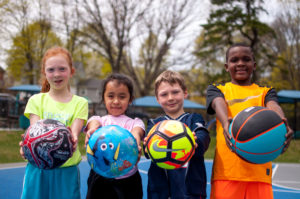WALTHAM – Participation in sports promotes physical activity, builds self-esteem, improves social skills and motivates children to excel academically.
To encourage Massachusetts students to be active and play sports, the American Heart Association and Newton-Wellesley Hospital are collecting hundreds of athletics balls that will be donated to schools throughout the state over the next month.

(Back row, left to right) Jocelyn Concepcion; Mary Blake, vice president, youth market, American Heart Association; Evan Libitz; Maureen Taddeo, principal, Plympton Elementary School; Dhaethmy Dorival; George Philippides, MD, Newton-Wellesley Hospital; Sam Claude; Alex Audette, assistant principal, Plympton Elementary School; Howie Rock, physical education teacher, Plympton Elementary School; Melissa Padeni, director, Boston Heart & Stroke Ball, American Heart Association.
(Front row, left to right) Nelson Gonzales, Dylan Remage-Healy, Bertha Vasquez, Max Polipas, Dana Hip Vasquez.
On Monday, the two organizations delivered their first donation of about two dozen balls to the Thomas R. Plympton Elementary School in Waltham.
A group of students joined school officials in the afternoon to accept – and test out – the new athletic equipment on the school’s outdoor basketball court. After posing for a picture, the kids spent about 20 minutes dribbling, shooting and kicking their new basketballs, soccer balls, volleyballs and kickballs.
Howie Rock, the school’s physical education teacher, said he hopes the new balls will encourage his students to learn games that will keep them active and healthy.
“Exercise doesn’t have to be difficult, especially at this age. It can be fun,” said Rock. “You want to show them different activities that they can do to stay involved, stay active through middle school, high school, and hopefully for life.”
Just like in adults, increased physical activity has been associated with an increased life expectancy and decreased risk of cardiovascular disease among children, said Dr. George R. Philippides, chief of cardiology at Newton-Wellesley Hospital. The American Heart Association recommends that children and adolescents participate in at least 60 minutes of moderate to vigorous physical activity every day.
“Donating playground balls to local schools in need is a great first step in keeping our youth active and heart healthy,” Philippides said.
Principal Maureen Taddeo said the school has worked hard to create a culture of health.

Thomas R. Plympton Elementary School students (left to right) Dylan Remage-Healy, Bertha Vasquez, Maz Polipas, and Sam Claude show off some of the athletic balls that the American Heart Association and Newton-Wellesley Hospital donated to their school on Monday.
The school has been a longtime participant in the American Heart Association’s Jump Rope For Heart program, a fundraising event that engages elementary and middle school students with jumping rope while empowering them to improve their own health and help other kids with heart-health issues. It also takes part in a before-school physical activity program called Build Our Kids Success and recently formed a health and wellness committee.
“Everything is in sync with promoting physical activity for the students and promoting better lifestyle choices,” said Taddeo.
